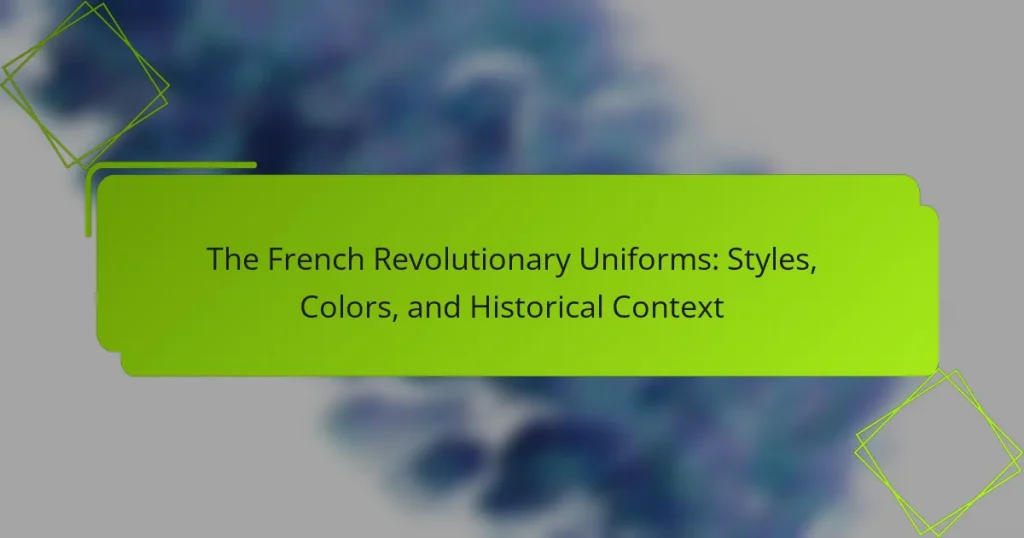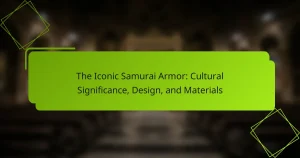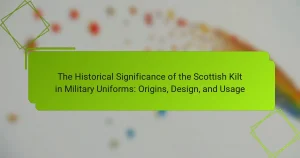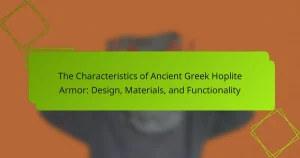French Revolutionary uniforms were the military outfits worn by soldiers during the French Revolution from 1789 to 1799, embodying the revolutionary ideals of liberty, equality, and fraternity. Characterized by their practical design and the use of blue, white, and red colors, these uniforms included elements like the habit-veste coat and tricolor cockades, which symbolized allegiance to the revolution. The evolution of these uniforms over the decade reflected changing political sentiments and military needs, while also fostering national identity and unity among troops. The standardization of military attire during this period not only distinguished revolutionary forces from royalist troops but also influenced military fashion in subsequent eras, promoting the concept of citizen-soldiers and leaving a lasting legacy in modern military uniforms.
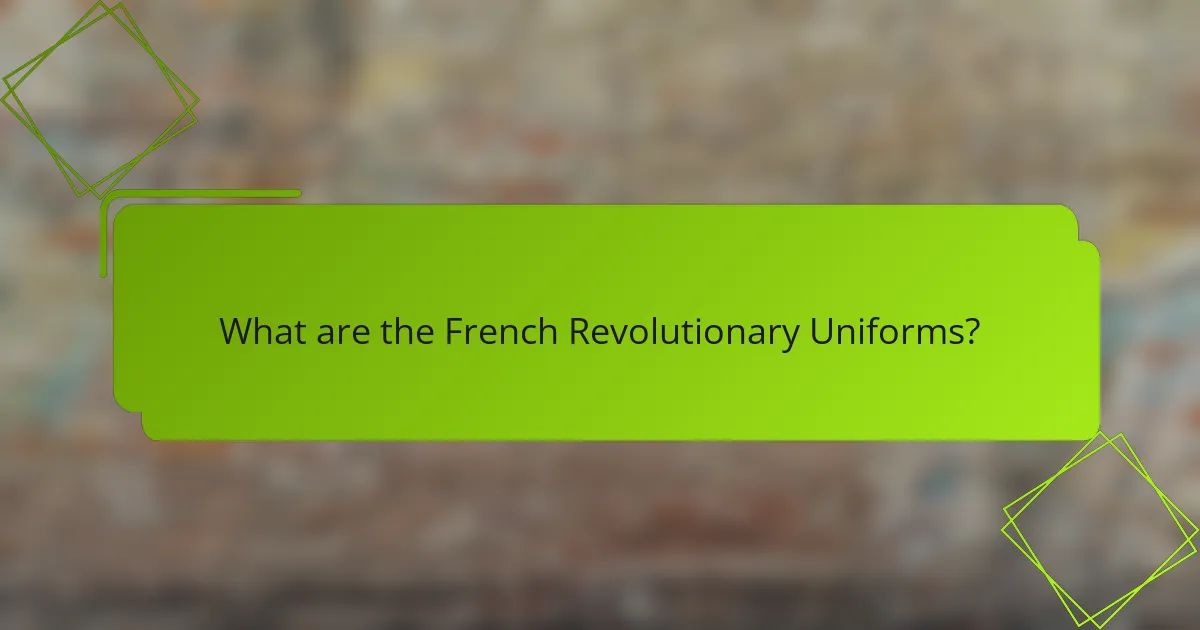
What are the French Revolutionary Uniforms?
French Revolutionary Uniforms were military outfits worn during the French Revolution from 1789 to 1799. These uniforms symbolized the revolutionary ideals of liberty, equality, and fraternity. The design featured a combination of practicality and patriotism, often utilizing blue, white, and red colors. Soldiers in the French Revolutionary Army typically wore a short coat known as a habit-veste. Trousers replaced the traditional breeches, reflecting a shift towards more egalitarian fashion. The cockade, a circular emblem, was also a prominent feature, representing allegiance to the revolution. Notably, the uniforms evolved over the decade, influenced by changing political sentiments and military needs. Historical records indicate that these uniforms played a crucial role in fostering national identity among the troops.
How did the French Revolutionary Uniforms evolve over time?
French Revolutionary uniforms evolved significantly from 1789 to 1804. Initially, uniforms were based on pre-revolutionary styles, reflecting traditional military attire. The early revolutionary phase emphasized simplicity and practicality. Bright colors, especially blue, white, and red, symbolized the revolution’s ideals. By the mid-1790s, uniforms became more standardized. The adoption of the “habit-veste” marked a shift toward more modern military attire. This style featured high collars and shorter coats. The influence of the Napoleonic era also introduced new elements. By 1804, uniforms became more elaborate, reflecting the empire’s grandeur. The evolution mirrored the political changes in France during this period.
What historical events influenced the design of these uniforms?
The design of French Revolutionary uniforms was influenced by several key historical events. The French Revolution itself, starting in 1789, emphasized egalitarianism and civic duty. This led to the adoption of simpler, more functional designs compared to the ornate styles of the monarchy. The rise of nationalism during the revolution inspired the use of tricolor motifs, reflecting the colors of the French flag. The Napoleonic Wars further shaped uniform design, as military efficiency became paramount. Additionally, the influence of the Enlightenment encouraged a move towards rationality in design. These events collectively transformed military attire into symbols of revolutionary ideals and national pride.
What were the key changes in uniform styles during the Revolution?
The key changes in uniform styles during the Revolution included the shift from ornate designs to simpler, more practical attire. Military uniforms transitioned from heavy fabrics and elaborate decorations to lighter materials suited for mobility. The introduction of the tricolor cockade became a significant symbol of revolutionary identity. Colors also evolved, with blue, white, and red becoming prominent in uniforms, reflecting national pride. Additionally, the use of standardized cuts and styles emerged to unify troops. These changes were influenced by the revolutionary ideals of equality and efficiency in the military. The new styles represented a departure from the aristocratic influences of the previous regime, aligning with the revolutionary spirit.
What styles characterized the French Revolutionary Uniforms?
French Revolutionary uniforms were characterized by a mix of traditional military styles and revolutionary symbolism. They often featured tricolor cockades, reflecting the national colors of France: blue, white, and red. The uniforms included short jackets, known as habit-veste, which were practical for movement. Trousers replaced breeches, symbolizing a shift towards egalitarianism. Epaulettes and plumed hats were common, denoting rank and unit affiliation. The use of simpler materials indicated a break from aristocratic fashion. These styles evolved throughout the revolution, influenced by the changing political climate. Uniforms became a representation of revolutionary ideals, emphasizing patriotism and unity among soldiers.
What were the most common styles worn by soldiers?
The most common styles worn by soldiers during the French Revolutionary period included the infantry uniform, cavalry uniform, and artillery uniform. Infantry soldiers typically wore a short blue coat with white facings. They also had white trousers and a cocked hat. Cavalry uniforms featured a more elaborate design, often with a longer coat and distinctive headgear. Artillery soldiers wore uniforms that were practical, often in blue and white, with specific insignias denoting their role. These styles reflected the revolutionary ideals of the time, emphasizing equality and national pride. The use of blue as a primary color symbolized loyalty and patriotism in the new republic.
How did civilian clothing influence military uniform styles?
Civilian clothing significantly influenced military uniform styles during the French Revolutionary period. The shift toward more practical and less ornate designs in civilian attire prompted similar changes in military uniforms. Tailored cuts and simpler fabrics became prevalent as military leaders sought to enhance mobility and comfort for soldiers. The adoption of bright colors and distinctive patterns in civilian dress inspired military uniforms to reflect national identity and pride. Notably, the French Revolutionary army incorporated elements like the bicorne hat and short coats, which mirrored civilian fashion trends of the time. This blending of styles helped to create a more unified and recognizable military appearance. The influence of civilian clothing on military uniforms marked a departure from the elaborate and rigid styles of previous eras.
What colors were prominent in French Revolutionary Uniforms?
Prominent colors in French Revolutionary uniforms included blue, white, and red. These colors symbolized the ideals of the Revolution. Blue often represented liberty, white stood for equality, and red signified fraternity. The use of these colors was standardized in the uniforms of the National Guard and other military units. The tricolor cockade, featuring these colors, became a national emblem. Historical records confirm that these colors were integral to the identity of revolutionary forces. The adoption of the tricolor flag further solidified their significance.
What significance did colors hold for the different factions?
Colors held significant meaning for the different factions during the French Revolution. Each faction used colors to symbolize their ideologies and affiliations. For example, the revolutionary forces prominently featured the color blue, representing liberty and the fight against oppression. The red color was associated with the blood of the martyrs and revolutionary fervor. The white color symbolized the monarchy and was often used by royalist factions. Additionally, the tricolor flag, consisting of blue, white, and red, became a national emblem representing unity and the principles of the Revolution. These colors helped to visually distinguish factions and communicate their political stances to the public.
How did color choices reflect the political climate of the time?
Color choices in French Revolutionary uniforms reflected the political climate by symbolizing revolutionary ideals and allegiances. Bright colors like blue, red, and white represented liberty, equality, and fraternity. The use of these colors was a direct response to the monarchy’s traditional colors, which were often associated with oppression. For instance, the revolutionary tricolor flag was adopted in 1790, merging the colors of Paris (blue and red) with the monarchy’s white. This shift signified a break from the past and the establishment of a new national identity. Additionally, uniform designs often included elements that represented specific political factions, further showcasing the dynamic political landscape of the time. The color choices thus served as visual markers of allegiance and ideological stance during a period of significant social upheaval.
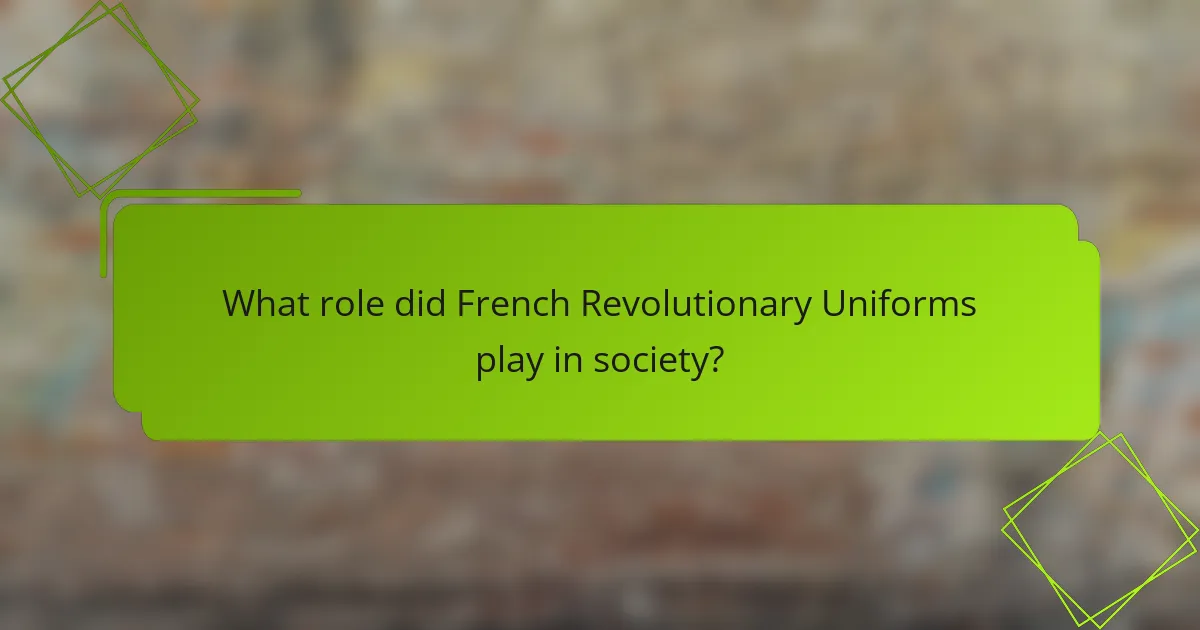
What role did French Revolutionary Uniforms play in society?
French Revolutionary uniforms played a significant role in society by symbolizing national identity and revolutionary ideals. These uniforms were designed to reflect the principles of liberty, equality, and fraternity. The introduction of standardized military attire helped to unify soldiers and foster a sense of camaraderie. Additionally, the colors and styles of the uniforms were often tied to political factions, influencing public perception. For example, the blue, white, and red colors represented the French flag and the revolution itself. Uniforms also served as a means of distinguishing revolutionary forces from royalist troops. This distinction was crucial during a time of civil unrest and conflict. Overall, French Revolutionary uniforms were more than mere clothing; they were powerful symbols of change and societal transformation.
How did uniforms symbolize national identity during the Revolution?
Uniforms during the Revolution symbolized national identity by representing the values and ideals of the new republic. They were designed to reflect revolutionary principles such as liberty, equality, and fraternity. The use of specific colors, like blue, white, and red, became emblematic of French nationalism. These colors were drawn from the national flag, reinforcing a collective identity among soldiers and citizens. Additionally, uniforms distinguished revolutionary forces from royalist troops, creating a visual representation of the conflict between old and new regimes. Historical records indicate that uniforms fostered a sense of unity and purpose among diverse groups fighting for the same cause. Thus, the symbolism of uniforms was integral to the formation of a cohesive national identity during this transformative period.
What messages were conveyed through the design and colors of the uniforms?
The design and colors of the French Revolutionary uniforms conveyed messages of unity, nationalism, and revolutionary ideals. The use of blue, white, and red symbolized the values of liberty, equality, and fraternity. These colors were also a direct reference to the French flag, reinforcing national pride. The uniform designs often featured elements that represented the military’s commitment to the republic. Additionally, the styles aimed to distinguish revolutionary soldiers from the monarchy’s forces. This differentiation was crucial in establishing a new identity for the French military. Overall, the uniforms served as a visual representation of the transformative spirit of the Revolution.
How did uniforms affect the morale of soldiers and civilians?
Uniforms significantly influenced the morale of soldiers and civilians during the French Revolution. Soldiers wearing uniforms felt a sense of pride and identity. This pride often translated into increased motivation and cohesion among troops. Civilians viewed uniforms as symbols of authority and order. This perception fostered respect and support for the military efforts. Historical evidence shows that well-designed uniforms contributed to the image of a disciplined army. For example, the introduction of the tricolor cockade became a symbol of the revolution, uniting soldiers and civilians alike. Overall, uniforms served to boost morale by creating a shared identity and purpose.
Why were uniforms important for military organization?
Uniforms were important for military organization because they established clear identification among troops. They differentiated between various units and ranks within the military. This differentiation enhanced unit cohesion and morale. Uniforms also promoted discipline and order during formations and maneuvers. Historically, uniforms became a symbol of national pride and unity. For instance, during the French Revolutionary Wars, distinct uniforms helped unify soldiers under revolutionary ideals. The use of specific colors and styles allowed for easy recognition on the battlefield. This recognition was crucial for effective communication and strategy execution in combat situations.
How did uniforms contribute to the structure and discipline of the army?
Uniforms contributed to the structure and discipline of the army by establishing a clear identity and hierarchy among soldiers. They standardized appearance, promoting unity and cohesion within units. This uniformity minimized confusion during battle and enhanced recognition of ranks. The use of specific colors and styles signified different regiments and roles, reinforcing organizational structure. Historical evidence shows that during the French Revolutionary period, uniforms were crucial in differentiating between various military factions. This differentiation was vital for maintaining order and discipline in chaotic environments. Uniforms also instilled a sense of pride and professionalism, motivating soldiers to adhere to military regulations and conduct.
What impact did uniformity have on the effectiveness of troops?
Uniformity significantly enhanced the effectiveness of troops during the French Revolutionary period. It fostered a sense of identity and cohesion among soldiers. Uniforms made it easier to recognize comrades on the battlefield. This recognition reduced the likelihood of friendly fire incidents. Additionally, a standardized appearance instilled discipline and morale. Historical records indicate that well-uniformed troops often performed better in coordinated maneuvers. The visual impact of uniforms also intimidated opponents, contributing to psychological warfare. Overall, uniformity played a crucial role in the operational success of military forces.

What are the lasting impacts of French Revolutionary Uniforms?
French Revolutionary uniforms significantly influenced military attire in subsequent eras. Their designs emphasized equality and national identity. The use of tricolor cockades symbolized revolutionary ideals. These uniforms inspired modern military uniforms in many countries. The adoption of standardized clothing began with the French Revolution. This standardization improved unit cohesion and morale. Additionally, the uniforms reflected broader social changes, promoting the idea of citizen-soldiers. Their legacy persists in contemporary military and ceremonial dress.
How have French Revolutionary Uniforms influenced modern military attire?
French Revolutionary uniforms significantly influenced modern military attire through their emphasis on color, style, and symbolism. The adoption of bold colors, such as blue and red, established a visual identity for military units. These colors are still prevalent in many contemporary military uniforms. Additionally, the use of epaulettes and distinctive headgear became common features in modern designs. The French military introduced structured tailoring, which improved functionality and comfort for soldiers. This tailoring approach is now standard in military uniforms worldwide. The revolutionary period also marked a shift towards uniforms that represented national identity. This trend continues today, as many countries incorporate national symbols in their military attire. Overall, the legacy of French Revolutionary uniforms is evident in the design and symbolism of modern military clothing.
What elements from these uniforms are still present in today’s military fashion?
Today’s military fashion retains elements such as epaulettes, high collars, and specific color schemes. Epaulettes, originally for rank identification, are still used in various forms on modern uniforms. High collars, prevalent in the French Revolutionary period, provide a formal appearance and are found in contemporary designs. The use of bold colors, particularly blue and red, continues to influence military uniforms, reflecting historical significance. Additionally, the structured silhouette of Revolutionary uniforms has evolved into the tailored cuts seen in modern attire. These elements highlight the enduring legacy of French Revolutionary uniforms in today’s military fashion.
What can we learn from the study of French Revolutionary Uniforms?
The study of French Revolutionary Uniforms reveals insights into military identity and social change. These uniforms symbolized the shift from monarchy to republicanism. They reflected the values of the Revolution, such as liberty and equality. The colors and styles indicated rank and affiliation with revolutionary ideals. For example, the adoption of blue, white, and red represented the national colors. Uniforms also showcased the transition from ornate designs to practical military attire. This evolution mirrored the broader societal changes during the Revolution. Overall, analyzing these uniforms provides a deeper understanding of the cultural and political dynamics of the time.
How can understanding these uniforms enhance our knowledge of historical events?
Understanding French Revolutionary uniforms enhances our knowledge of historical events by providing insights into the socio-political climate of the time. These uniforms reflect the values and ideologies of the revolution, such as liberty, equality, and fraternity. The colors and styles used in the uniforms symbolize the different factions and their beliefs during the revolution. For instance, the use of blue, white, and red represents the national colors of France and the desire for unity. Analyzing the evolution of these uniforms reveals shifts in military strategy and public sentiment. Historical documents, such as military records and contemporary accounts, further illustrate how uniforms were a means of identity and propaganda. By studying these uniforms, we can better understand the impact of the revolution on French society and its lasting legacy.
What lessons about identity and representation can be drawn from their styles?
The styles of French Revolutionary uniforms convey significant lessons about identity and representation. These uniforms symbolize the values of the Revolution, such as liberty, equality, and fraternity. The use of specific colors, like blue, white, and red, reflects national identity and unity. The design of the uniforms often included elements that represented the common citizen, breaking away from aristocratic traditions. This shift emphasized the importance of the individual within the collective national identity. Historical records show that these uniforms were intended to create a sense of belonging among soldiers and citizens alike. The adoption of these styles marked a departure from previous military aesthetics, aligning with revolutionary ideals. Thus, the uniforms serve as a visual representation of the radical changes in societal values during the French Revolution.
What tips can help in the study of French Revolutionary Uniforms?
To study French Revolutionary uniforms effectively, focus on primary sources and visual references. Analyzing paintings and illustrations from the era provides insight into styles and colors. Researching military regulations from the Revolutionary period reveals official uniform specifications. Consulting books and articles by historians specializing in the French Revolution enhances understanding. Examining museum collections can offer access to original garments and artifacts. Joining online forums or study groups allows for discussion and exchange of knowledge. Attending lectures or workshops on military history can deepen comprehension of the context. Utilizing academic databases for scholarly articles ensures access to credible information.
What resources are recommended for deeper research on this topic?
Recommended resources for deeper research on French Revolutionary uniforms include “The Uniforms of the French Revolutionary Wars” by Philip Haythornthwaite. This book provides detailed illustrations and descriptions of various military outfits from the era. Another valuable source is “The French Army 1789-1815” by Ian Fletcher, which covers the evolution of military dress during the Revolution. The journal “Military History” often features articles on this topic, offering scholarly insights. Additionally, the online database JSTOR contains numerous academic papers discussing the historical context of these uniforms. These resources collectively provide a comprehensive understanding of styles, colors, and their significance.
How can one effectively analyze the symbolism in these uniforms?
To effectively analyze the symbolism in French Revolutionary uniforms, one should examine their colors, designs, and historical context. Colors often represent political ideals; for example, blue, white, and red symbolize liberty, equality, and fraternity. The design elements, such as epaulettes and sashes, convey rank and military structure. Historical context is crucial; uniforms evolved from royal styles to reflect revolutionary values. Analyzing primary sources, like paintings and documents from the era, provides insight into the intended symbolism. Additionally, comparing uniforms across different factions reveals varying interpretations of revolutionary ideals. This methodical approach enhances understanding of the uniforms’ significance in the revolutionary narrative.
The French Revolutionary Uniforms were military outfits worn from 1789 to 1799, symbolizing the revolutionary ideals of liberty, equality, and fraternity. Characterized by practical designs, these uniforms featured blue, white, and red colors, with styles evolving from traditional military attire to more modern forms influenced by political changes. Key elements included the habit-veste, tricolor cockades, and standardized cuts that fostered national identity and unity among soldiers. The article explores the historical context, significance of colors, and the impact of these uniforms on modern military attire, providing insights into their role in shaping military organization and societal transformation during the French Revolution.
